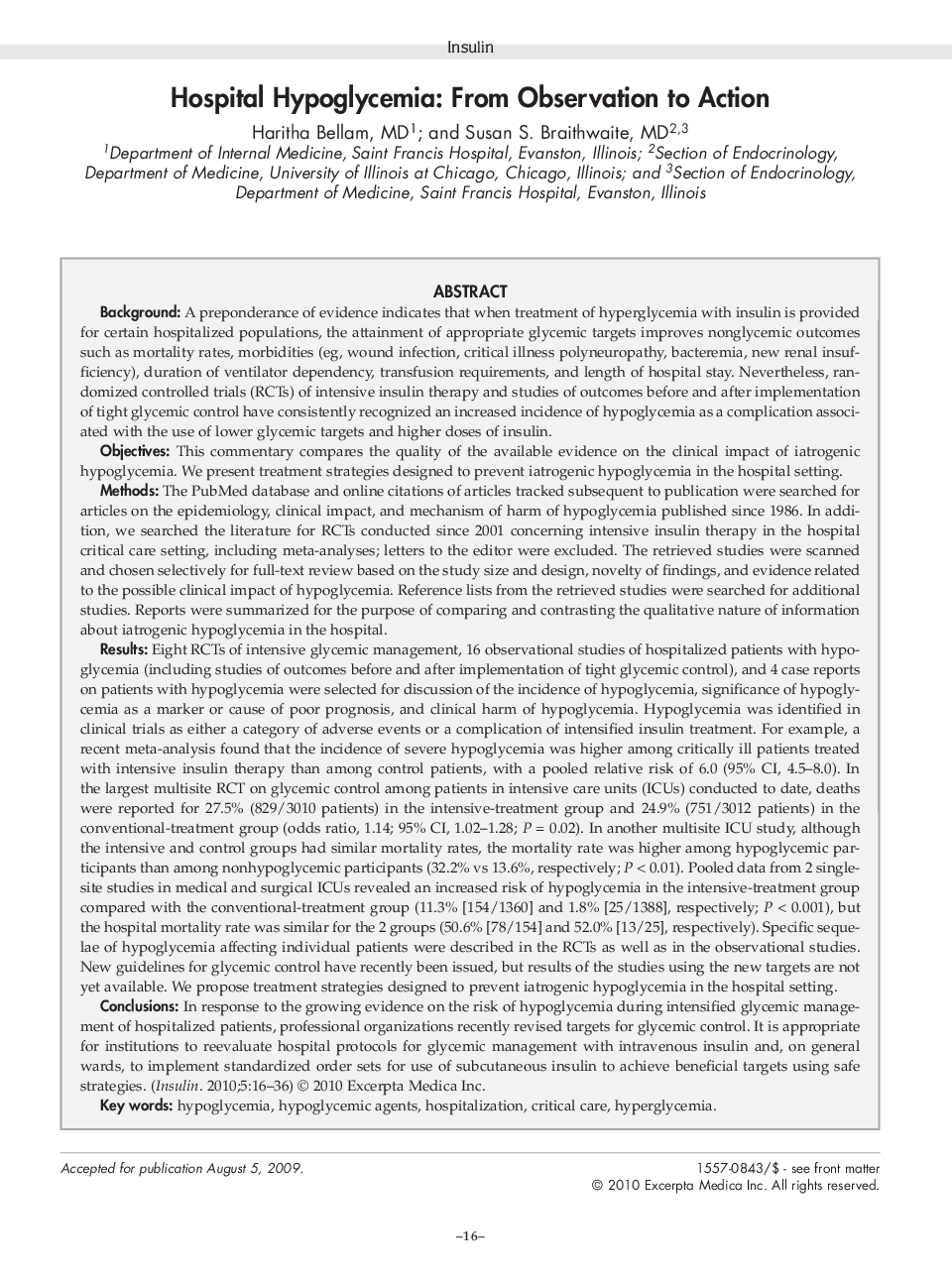| کد مقاله | کد نشریه | سال انتشار | مقاله انگلیسی | نسخه تمام متن |
|---|---|---|---|---|
| 2803708 | 1568963 | 2010 | 21 صفحه PDF | دانلود رایگان |

Background: A preponderance of evidence indicates that when treatment of hyperglycemia with insulin is provided for certain hospitalized populations, the attainment of appropriate glycemic targets improves nonglycemic outcomes such as mortality rates, morbidities (eg, wound infection, critical illness polyneuropathy, bacteremia, new renal insufficiency), duration of ventilator dependency, transfusion requirements, and length of hospital stay. Nevertheless, randomized controlled trials (RCTs) of intensive insulin therapy and studies of outcomes before and after implementation of tight glycemic control have consistently recognized an increased incidence of hypoglycemia as a complication associated with the use of lower glycemic targets and higher doses of insulin.Objectives: This commentary compares the quality of the available evidence on the clinical impact of iatrogenic hypoglycemia. We present treatment strategies designed to prevent iatrogenic hypoglycemia in the hospital setting.Methods: The PubMed database and online citations of articles tracked subsequent to publication were searched for articles on the epidemiology, clinical impact, and mechanism of harm of hypoglycemia published since 1986. In addition, we searched the literature for RCTs conducted since 2001 concerning intensive insulin therapy in the hospital critical care setting, including meta-analyses; letters to the editor were excluded. The retrieved studies were scanned and chosen selectively for full-text review based on the study size and design, novelty of findings, and evidence related to the possible clinical impact of hypoglycemia. Reference lists from the retrieved studies were searched for additional studies. Reports were summarized for the purpose of comparing and contrasting the qualitative nature of information about iatrogenic hypoglycemia in the hospital.Results: Eight RCTs of intensive glycemic management, 16 observational studies of hospitalized patients with hypoglycemia (including studies of outcomes before and after implementation of tight glycemic control), and 4 case reports on patients with hypoglycemia were selected for discussion of the incidence of hypoglycemia, significance of hypoglycemia as a marker or cause of poor prognosis, and clinical harm of hypoglycemia. Hypoglycemia was identified in clinical trials as either a category of adverse events or a complication of intensified insulin treatment. For example, a recent meta-analysis found that the incidence of severe hypoglycemia was higher among critically ill patients treated with intensive insulin therapy than among control patients, with a pooled relative risk of 6.0 (95% CI, 4.5–8.0). In the largest multisite RCT on glycemic control among patients in intensive care units (ICUs) conducted to date, deaths were reported for 27.5% (829/3010 patients) in the intensive-treatment group and 24.9% (751/3012 patients) in the conventional-treatment group (odds ratio, 1.14; 95% CI, 1.02–1.28; P = 0.02). In another multisite ICU study, although the intensive and control groups had similar mortality rates, the mortality rate was higher among hypoglycemic participants than among nonhypoglycemic participants (32.2% vs 13.6%, respectively; P < 0.01). Pooled data from 2 singlesite studies in medical and surgical ICUs revealed an increased risk of hypoglycemia in the intensive-treatment group compared with the conventional-treatment group (11.3% [154/1360] and 1.8% [25/1388], respectively; P < 0.001), but the hospital mortality rate was similar for the 2 groups (50.6% [78/154] and 52.0% [13/25], respectively). Specific sequelae of hypoglycemia affecting individual patients were described in the RCTs as well as in the observational studies. New guidelines for glycemic control have recently been issued, but results of the studies using the new targets are not yet available. We propose treatment strategies designed to prevent iatrogenic hypoglycemia in the hospital setting.Conclusions: In response to the growing evidence on the risk of hypoglycemia during intensified glycemic management of hospitalized patients, professional organizations recently revised targets for glycemic control. It is appropriate for institutions to reevaluate hospital protocols for glycemic management with intravenous insulin and, on general wards, to implement standardized order sets for use of subcutaneous insulin to achieve beneficial targets using safe strategies.
Journal: Insulin - Volume 5, Issue 1, January 2010, Pages 16-36